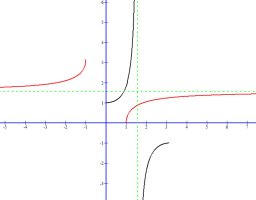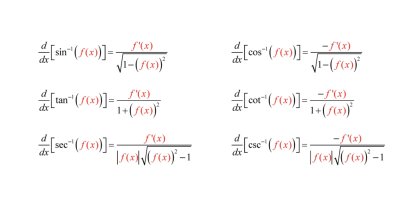Find the derivative of 3cos^-1(sqrt x)
- Thread starter Lalala
- Start date
blamocur
Elite Member
- Joined
- Oct 30, 2021
- Messages
- 3,212
READ BEFORE POSTING
Welcome to FreeMathHelp.com! Please take the time to read the following before you make your first post. It will help you to get your math questions answered promptly and in the most helpful manner. A summary is available here, but please read the complete guidelines below at your earliest...
www.freemathhelp.com
skeeter
Elite Member
- Joined
- Dec 15, 2005
- Messages
- 3,216
Hi skeeter.
I am a professional calculus student, but I don't understand this:
Why do we need to put an absolute symbol around f(x) for the derivative of secant and cosecant inverse?
Steven G
Elite Member
- Joined
- Dec 30, 2014
- Messages
- 14,591
Please show us your work and either you'll see why there are absolute value bars or someone here will point it out. Or is skeeter wrong? ( I doubt that!)Hi skeeter.
I am a professional calculus student, but I don't understand this:
Why do we need to put an absolute symbol around f(x) for the derivative of secant and cosecant inverse?
skeeter
Elite Member
- Joined
- Dec 15, 2005
- Messages
- 3,216
Shown is graph of the basic secant function in black with domain restricted to [0,2π)∪(2π,π] so that it passes the horizontal line test for the existence of an inverse function.
Reflection over the line y = x is the inverse secant function in red ... note its domain is (−∞,−1]∪[1,∞) and range [0,2π)∪(2π,1].
What do you notice about the slope of the inverse secant function?

Reflection over the line y = x is the inverse secant function in red ... note its domain is (−∞,−1]∪[1,∞) and range [0,2π)∪(2π,1].
What do you notice about the slope of the inverse secant function?

Dr.Peterson
Elite Member
- Joined
- Nov 12, 2017
- Messages
- 16,828
We need to do that because that's what it works out to be!Hi skeeter.
I am a professional calculus student, but I don't understand this:
Why do we need to put an absolute symbol around f(x) for the derivative of secant and cosecant inverse?
On the other hand ...
My understanding is that some people define arcsec with a different range, namely [0,π/2)∪(π,3π/2). in order to avoid the need for the absolute value in the derivative. I see no other reason to prefer that definition, and several reasons not to, which probably explains what it is not popular.
I mentioned this here; I think this is the place where I learned about it.
It is also mentioned in Wikipedia, with no citation:
Note: Some authors[citation needed] define the range of arcsecant to be
 , because the tangent function is nonnegative on this domain. This makes some computations more consistent. For example, using this range,
, because the tangent function is nonnegative on this domain. This makes some computations more consistent. For example, using this range,
 whereas with the range
whereas with the range
 , we would have to write
, we would have to write
 since tangent is nonnegative on
since tangent is nonnegative on
 but nonpositive on
but nonpositive on







I don't think I've ever found an actual use of the alternative range, myself.
What range does it have in your experience?
On the other hand, MathWorld presents a version of the derivative (using the standard definition) that avoids the absolute value:
The derivative of
 is
is


| (2) |
which simplifies to

| (3) |
for
 .
.

Please show us your work and either you'll see why there are absolute value bars or someone here will point it out. Or is skeeter wrong? ( I doubt that!)
Shown is graph of the basic secant function in black with domain restricted to [0,2π)∪(2π,π] so that it passes the horizontal line test for the existence of an inverse function.
Reflection over the line y = x is the inverse secant function in red ... note its domain is (−∞,−1]∪[1,∞) and range [0,2π)∪(2π,1].
What do you notice about the slope of the inverse secant function?
View attachment 37178
So, basically, the derivative of the secant inverse is always positive. Omitting the absolute symbol will result in negative slope when taking x<−1.We need to do that because that's what it works out to be!
On the other hand ...
My understanding is that some people define arcsec with a different range, namely [0,π/2)∪(π,3π/2). in order to avoid the need for the absolute value in the derivative. I see no other reason to prefer that definition, and several reasons not to, which probably explains what it is not popular.
I mentioned this here; I think this is the place where I learned about it.
It is also mentioned in Wikipedia, with no citation:
Note: Some authors[citation needed] define the range of arcsecant to be, because the tangent function is nonnegative on this domain. This makes some computations more consistent. For example, using this range, whereas with the range
whereas with the range , we would have to write
, we would have to write since tangent is nonnegative on
since tangent is nonnegative on but nonpositive on
but nonpositive on

I don't think I've ever found an actual use of the alternative range, myself.
What range does it have in your experience?
On the other hand, MathWorld presents a version of the derivative (using the standard definition) that avoids the absolute value:
The derivative ofis

which simplifies to

for.
In my opinion, changing the range to get rid of the absolute symbol is just making the function more complicated as well as we need to define that new range every time we encounter the secant inverse function.
I think that the best solution is just to stick with the absolute symbol or to write its derivative in this clever way:
x21−x211
A few years ago, when I wrote the derivative of the secant inverse as xx2−11 did not know that this only true for x>1.
No one told me that I have to include the absolute symbol in my derivative. Thank god I have seen this post and got the correct full picture of the secant and cosecant inverse derivatives.
Thank you guys.
Dr.Peterson
Elite Member
- Joined
- Nov 12, 2017
- Messages
- 16,828
Where had you found that expression for the derivative? That's what my ultimate question for you was: Did it come from a source with a different definition for the range, or was it just a mistake of some sort (yours or theirs)?A few years ago, when I wrote the derivative of the secant inverse as xx2−11 did not know that this only true for x>1.
No one told me that I have to include the absolute symbol in my derivative. Thank god I have seen this post and got the correct full picture of the secant and cosecant inverse derivatives.
Looking around, I do find at least one site that leaves out the absolute value, apparently out of neglect; their proof omits consideration of sign. So there are definitely mistakes out there.
Where had you found that expression for the derivative? That's what my ultimate question for you was: Did it come from a source with a different definition for the range, or was it just a mistake of some sort (yours or theirs)?
Looking around, I do find at least one site that leaves out the absolute value, apparently out of neglect; their proof omits consideration of sign. So there are definitely mistakes out there.
It's the mistake of the instructor who has derived the derivative of the secant inverse without mentioning the absolute value or the domain at all. She derived it the same way of this website you are giving and we have taken that method as a standard way of deriving other inverse trigonometric functions. I now remember the book of the course that I was reading was using the absolute value, but that did not bother me because I thought that it might be a typo or something not important. When skeeter wrote the derivatives of the inverses, I was wondering if that absolute value was a typo too. I was curious to understand its story and did not come in my mind at all that it was because of the positive slope of the secant inverse function. I just knew that now. Everyday, we learn something new. Dr.Peterson said that.

